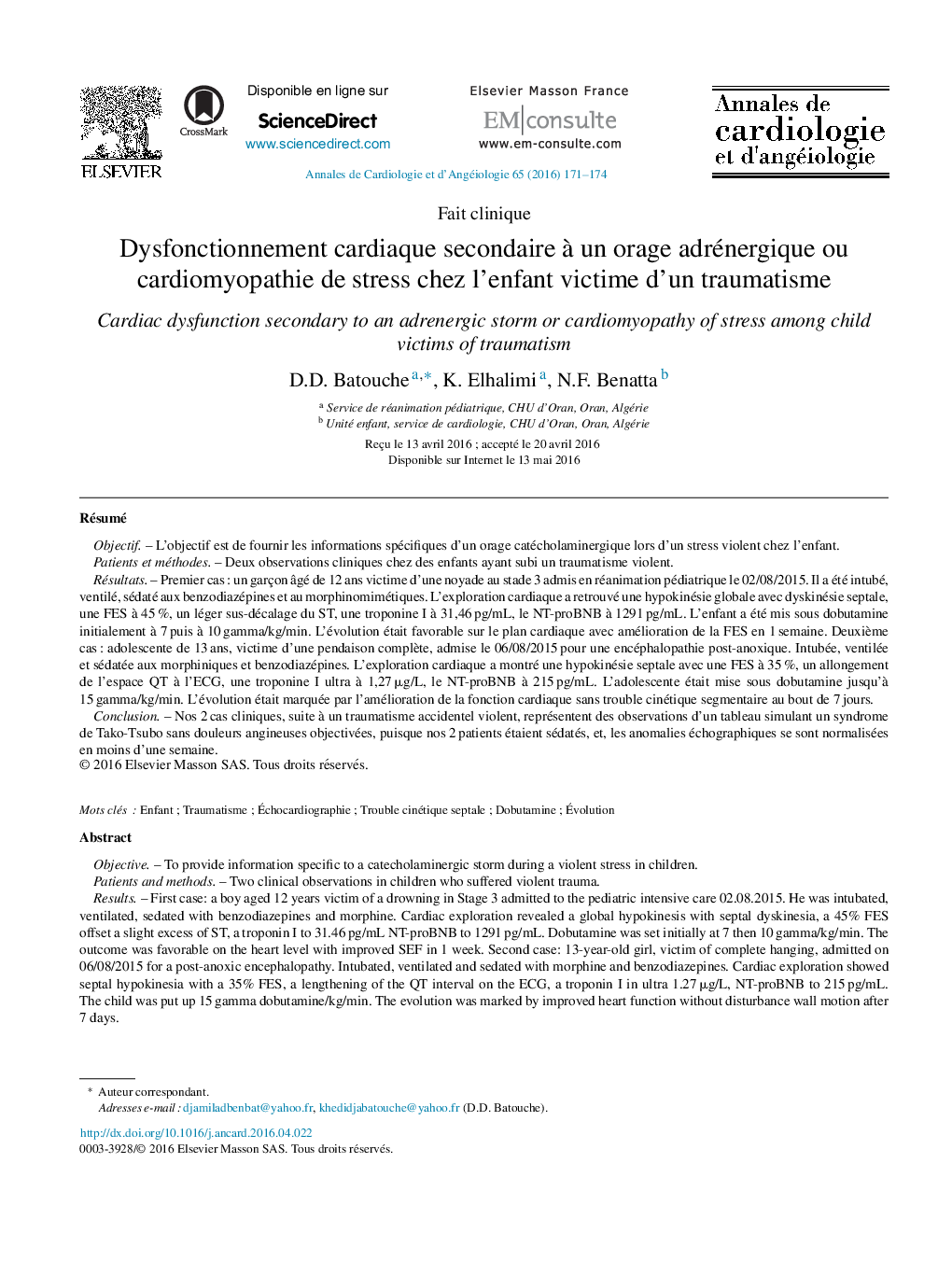| کد مقاله | کد نشریه | سال انتشار | مقاله انگلیسی | نسخه تمام متن |
|---|---|---|---|---|
| 2868429 | 1171195 | 2016 | 4 صفحه PDF | دانلود رایگان |

RésuméObjectifL’objectif est de fournir les informations spécifiques d’un orage catécholaminergique lors d’un stress violent chez l’enfant.Patients et méthodesDeux observations cliniques chez des enfants ayant subi un traumatisme violent.RésultatsPremier cas : un garçon âgé de 12 ans victime d’une noyade au stade 3 admis en réanimation pédiatrique le 02/08/2015. Il a été intubé, ventilé, sédaté aux benzodiazépines et au morphinomimétiques. L’exploration cardiaque a retrouvé une hypokinésie globale avec dyskinésie septale, une FES à 45 %, un léger sus-décalage du ST, une troponine I à 31,46 pg/mL, le NT-proBNB à 1291 pg/mL. L’enfant a été mis sous dobutamine initialement à 7 puis à 10 gamma/kg/min. L’évolution était favorable sur le plan cardiaque avec amélioration de la FES en 1 semaine. Deuxième cas : adolescente de 13 ans, victime d’une pendaison complète, admise le 06/08/2015 pour une encéphalopathie post-anoxique. Intubée, ventilée et sédatée aux morphiniques et benzodiazépines. L’exploration cardiaque a montré une hypokinésie septale avec une FES à 35 %, un allongement de l’espace QT à l’ECG, une troponine I ultra à 1,27 μg/L, le NT-proBNB à 215 pg/mL. L’adolescente était mise sous dobutamine jusqu’à 15 gamma/kg/min. L’évolution était marquée par l’amélioration de la fonction cardiaque sans trouble cinétique segmentaire au bout de 7 jours.ConclusionNos 2 cas cliniques, suite à un traumatisme accidentel violent, représentent des observations d’un tableau simulant un syndrome de Tako-Tsubo sans douleurs angineuses objectivées, puisque nos 2 patients étaient sédatés, et, les anomalies échographiques se sont normalisées en moins d’une semaine.
ObjectiveTo provide information specific to a catecholaminergic storm during a violent stress in children.Patients and methodsTwo clinical observations in children who suffered violent trauma.ResultsFirst case: a boy aged 12 years victim of a drowning in Stage 3 admitted to the pediatric intensive care 02.08.2015. He was intubated, ventilated, sedated with benzodiazepines and morphine. Cardiac exploration revealed a global hypokinesis with septal dyskinesia, a 45% FES offset a slight excess of ST, a troponin I to 31.46 pg/mL NT-proBNB to 1291 pg/mL. Dobutamine was set initially at 7 then 10 gamma/kg/min. The outcome was favorable on the heart level with improved SEF in 1 week. Second case: 13-year-old girl, victim of complete hanging, admitted on 06/08/2015 for a post-anoxic encephalopathy. Intubated, ventilated and sedated with morphine and benzodiazepines. Cardiac exploration showed septal hypokinesia with a 35% FES, a lengthening of the QT interval on the ECG, a troponin I in ultra 1.27 μg/L, NT-proBNB to 215 pg/mL. The child was put up 15 gamma dobutamine/kg/min. The evolution was marked by improved heart function without disturbance wall motion after 7 days.ConclusionOur 2 clinical cases following accidental trauma violating represent observations of a picture simulating a syndrome of Tako-Tsubo without anginal pain objectified as our 2 patients were sedated and ultrasound abnormalities returned to normal in less than a week.
Journal: Annales de Cardiologie et d'Angéiologie - Volume 65, Issue 3, June 2016, Pages 171–174